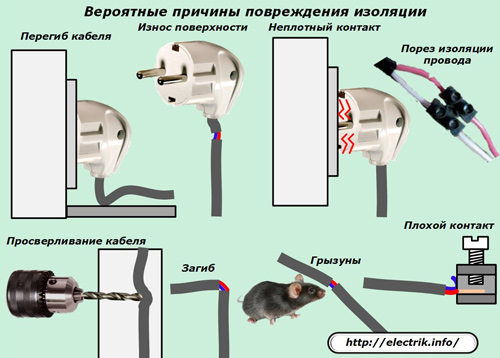Categories: Featured Articles » Electrician at home
Number of views: 14691
Comments on the article: 0
How to make wiring in the house from SIP panels
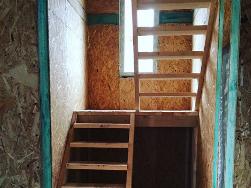 Using electric energy, the owner of any building is interested in ensuring maximum safety during long-term operation with a high degree of reliability. These issues are especially acute in houses built of combustible materials:
Using electric energy, the owner of any building is interested in ensuring maximum safety during long-term operation with a high degree of reliability. These issues are especially acute in houses built of combustible materials:
-
a tree;
-
timber;
-
SIP panels.
The latest designs have long been widely used in North America, Canada, and the Scandinavian countries. A few decades ago, they began to be built in the CIS countries.
SIP, for reference, refers to a panel with a structure made of insulating materials, when a layer of polystyrene foam is placed between two plates of OSB, which we commonly call foam. This filler may burn well, as it was in the Lame Horse building in Perm, or may not support combustion with a self-extinguishing structure that uses antipyrine additives. The quality of both grades of material can be checked on a small piece of matchstick fire. Their cost, of course, is different.
Well-known construction companies are engaged in the manufacture of buildings from SIW panels in the west. They assemble ready-made blocks in the factory according to the standard proven technology, and the house is assembled at the installation site by a trained team of several people quite quickly.
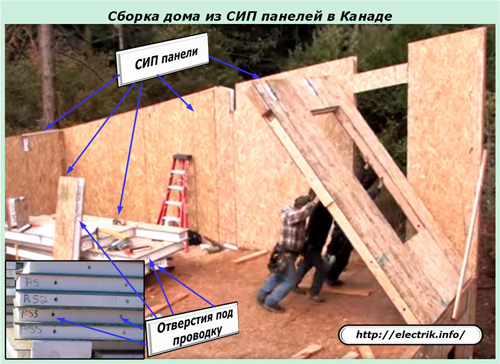
The creation of all life support communications, including ventilation systems, water supply, the use of electric energy and others, is well thought out and implemented by the project. Through wiring inside the panels, through holes have already been made.
In our countries, frame buildings do not yet have such a distribution, and the construction companies involved in their construction are put in slightly different working conditions due to differences in legislation and technology.
What is the danger of wiring in a house from SIP panels
Oriented particle boards (OSB) and polystyrene, even when impregnated with flame retardant compounds, are materials prone to fire, and electrical wires and devices are most often sources of open fire.
Causes of fire wiring
Conducting lines consist of metal conductors connected in different ways and an insulation layer between them. Fire may occur:
1. when overloading the permissible power;
2. in the event of a short circuit in the circuit;
3. under the influence of leakage currents on the ground;
4. due to the formation of an electric arc inside the cable or its connection points.
The issue of eliminating overloads and short circuit currents assigned to circuit breakers. Disconnecting circuits with emerging leakage currents are designed to fight RCD and differential automata. And let's pay special attention to the fourth point of a possible fire, we will analyze it in more detail.
An electric arc can occur as a result of:
1. coking of the insulation layer at the points of connection of electrical cores;
2. the formation of microcracks inside the dielectric layer with the creation of a resistive circuit.

How does coking of insulation occur?
When the conductor connected to the terminal block or other connector is damaged or its clamp is not tight enough, then a local heat spot is formed under the action of the current passing through the connection point. Over time, it causes carbonization of the insulation, when a layer of soot gradually accumulates.
Soot consists of carbon, which is a conductive material. Therefore, leakage currents occur through it.
The heating of the heat spot and the emission of soot occur spontaneously. Conducting paths are formed non-uniformly and between them electric arcs are created that continue the coking process.
As a result, a critical situation arises when the amount of carbon reaches a value sufficient to form an electric arc that can spontaneously ignite the insulation.
How does a resistive short circuit occur?
Manufacturers of cables and electric wires for their products provide technical standards for operation: storage, transportation, installation, prevention of mechanical bends and loads, exposure to hazardous environmental factors and other characteristics.
In most cases, when they are insignificantly, and not only, broken in the dielectric layer, microcracks are created that do not particularly affect the operability at the initial moment of the cable when it is put into operation. Over time, aging of the insulation occurs. Leaks form through such places.
They are too weak to cause a short circuit and overload, the currents of which are set by the circuit breaker. Again they do not go through the contour of the earth. Therefore, an RCD or a difavtomat cannot react to them.
As a result, they continue to develop, forming a carbon layer between the two conductors, which gradually accumulates and creates an electric arc inside the cable.
In coking and resistive faults, a common prerequisite for the appearance of an electric arc is the formation of carbon between live parts. Then the conditions for its ignition are created and a fire develops.
The most common causes of insulation damage are shown in the picture.
The erroneous opinion of electricians
Among most wiring professionals, there is a belief that cables are made very reliably. They can be thrown, pulled at the ends through pipelines, bent during installation and even stomped with their feet. So they do.
In their practice, electricians often observe cases of poor contacts occurring inside various terminal blocks and connectors, and the insulation state of cables and wires is usually hidden inside walls or closed channels.
Features of the occurrence of an electric arc
Between two opposite potentials of energy in the air, its ionization is possible. When it occurs, a gas discharge current is created containing plasma with a temperature of about 6 ÷ 10 thousand degrees. It is quite enough to ignite insulation, molten copper, a fire.
Only such heating in home wiring does not occur immediately, but develops in stages. At the initial stage, leakage currents are created, slightly overloading the electrical network, which operate secretly.
The development of the arc is facilitated by the opening of circuits with large inductances (powerful induction motors, for example), which create high self-induction voltages when the current flows through them abruptly, as well as alternating load alternations from minimum to maximum values.
To form an electric arc, it is enough to exceed the voltage between the electrodes of 15 volts and a current of 0.3 A.
How PUE prevents the causes of fire wiring in the house from SIP panels
The seventh edition of the main legislative document for electricians, in its clause 7.1.38, strictly regulates the choice of wires and cables and how to lay them in buildings made of combustible materials, recommending the main method for arranging wires - open on the surface of building structures.
At the same time, passages through walls, ceilings and partitions are considered as elements of hidden wiring, to which the requirements are tightened:
-
mandatory installation of cables and wires in sealed metal structures from pipes or ducts that can localize a possible fire;
-
using only cables whose insulation does not support combustion;
-
providing access to all wiring points to replace it.
It is difficult to fulfill these requirements, and not to comply is dangerous.Owners of building from SIW panels, like builders, are faced with the choice of wiring method. If it is done secretly, it is necessary to spend a large sum of money on the purchase of materials and their complex installation. Open wiring violates the aesthetic appearance of rooms.
The first experience of building a house from SIP panels. Engineering Communication:
Wiring Methods
Open method
Cable channels
On the surface of the OSB plate, sheets of drywall are mounted in a continuous layer. They are not combustible; they separate the wires from the SIP panel. Mounted on them external cable channel.
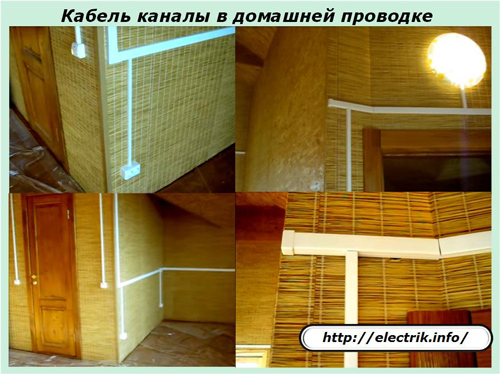
This method meets the requirements of the PUE, provides the minimum conditions for a beautiful view of the rooms.
Decorative skirting boards
The joints between the wall surfaces and the floor or ceiling, sheathed with drywall, can be used to place electric wires in them.
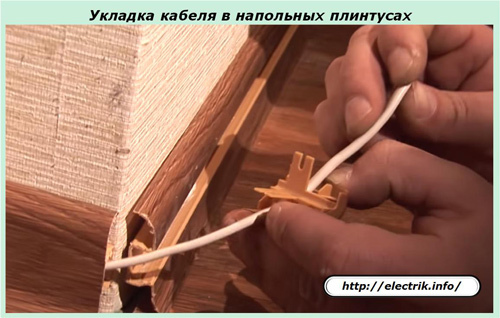
Skirting manufacturers produce special models that have enough volume to accommodate wiring. Modules for mounting sockets and other switching devices are manufactured for them.
Retro wiring
A popular design style involves the design of an antique apartment using modern electrical materials in a household home network.
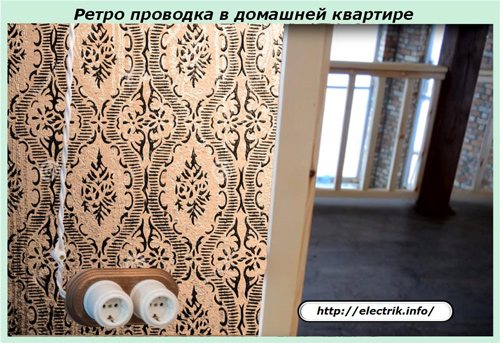
The wires are laid away from the wall due to the lay on porcelain casters, and antique sockets and switches are mounted on decorative socket boxes with a hidden metal insert. An insulating layer of wires is created with a coating that prevents exposure to sunlight.
Despite the ease of installation, retro wiring is not a budget solution. All its components are expensive.
What do apartment owners do
Special drywall niches
The creation of special compartments of non-combustible sheets in the horizontal or vertical plane of the arrangement allows you to place various communications in them.
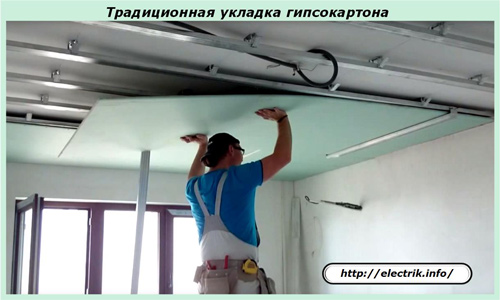
At the same time, part of the living space is reduced, but not critical for living.
Drywall triple layer
Inside the middle layer between the outer and the initial sheets create channels for the placement of cables and wires.
The method is affordable, but costly.
Attention! Electrical communications that are hidden in niches, partitions made of drywall, suspended ceilings are considered by the rules of PUE methods of performing closed wiring. This is a violation of existing safety standards. According to the rules, it is necessary to create sealed metal boxes with their connection in a common circuit for grounding and equalization of potentials.
Wiring in metal pipes
So far, this is the only permitted method of laying closed electrical wiring in buildings made of SIP panels for home owners in Russia.
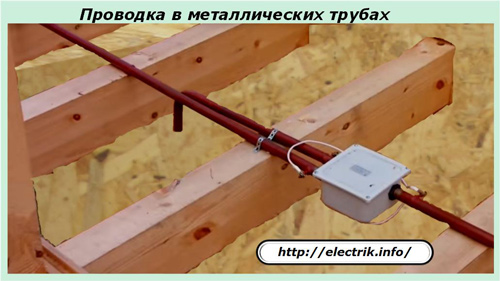
Each cable is separated by a layer of metal from a flammable surface. This installation is correct in terms of security, but it is not so simple to perform, and quite expensive.
How to lay electrical wiring in houses from SIP panels in the West
If you look at the first drawing of the article, where a team of workers installs a panel, it shows that the lines for electric wires were already drilled in it at the factory. And they put them there without any pipes and airtight cavities of metal that impede the access of air when ignited.
This is explained by a different approach to solving fire safety issues, and not by the negligence of construction organizations and the carelessness of building owners.
In 1996, Siemens successfully developed a new type of protection for residential buildings that responds to the beginning of the appearance of an electric arc in the 0.4 kilovolt electrical wiring. Until 1999, these devices were mass tested and received a state certificate.
After that, the installation technology for arc protection became mandatory in Western countries, Canada and America.After its application, the number of accidents associated with fires due to electrical wiring disturbances decreased by about 58%.
Protection comes in the form of modules, din rail mounted inside the dashboard and takes up little space in it.

How arc protection works
The idea of such devices is not new. They were widely used even before the development of Siemens in energy systems of all countries for electric power supply networks with voltage of 04 ÷ 35 kV.
Such arc protection is mounted in switchgears consisting of closed metal cabinets or compartments. It can respond to the occurrence of an electric arc due to:
-
flashes of light accompanying the flow of current in an ionization gas medium;
-
or a sharp increase in pressure inside the closed volume.
For this, various sensors are used:
-
lights, for example photothyristors;
-
pressures, including conventional limit switches pressed by manhole covers that recline under the influence of an explosion or other operating principle.
The signal from the sensors is fed to the logical part of the protection, which according to the prepared algorithms sequentially disconnects the necessary sources and consumers of current, and then starts the automatic fire extinguishing means.
It is clear that inside the home wiring such a technology is unacceptable for complex technical reasons, so it was not implemented.
The developers of arc protection for residential buildings have taken a different path. They analyzed the initial processes that occur during the formation of leakage currents through microcracks in the insulation layer and concluded that the shape of the current and voltage signals at this moment differs from the ideal sinusoid, undergoes significant changes.
One of the variants of signal distortion at the beginning of the appearance of the arc, when it crosses the zero value of the sinusoid, is shown in the picture. A small voltage is required for ionization currents to flow.
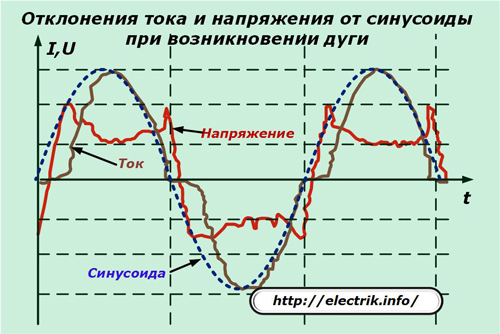
Monitoring current and voltage sensors of modular arc protection devices constantly analyze the forms of signals passing through them. Next is a comparison with a sine wave, and when differences are detected, the network is disconnected.
Arc Protection Locations
Arc detectors - these are the names of these modules abroad. They are used to limit the risks of fires during arcing in the terminal devices of stationary circuits and are mounted in switchboards to control the critical supply chains of outlet groups and fixtures of residential buildings with bedrooms and living rooms.
In addition, they are recommended to be installed in buildings with:
-
risks of open flames, for example with a forced ventilation system;
-
high density crowds (shops, cinemas);
-
stored flammable materials;
-
difficult exits for emergency evacuation.
International Standard Recommendations
Since the beginning of 2014, IEC 60364 part 4–42 has been recommending that electricity consumers use AFDDs that comply with IEC 62606 for fire safety.
The requirements of the Russian PUE so far do not legally allow electricians to carry out wiring in houses from SIP panels according to Western standards.
The solution of fire safety in residential buildings is provided not only by the correct installation of electrical wiring, but also by a set of other measures, including:
-
installation and proper operation automatic fire alarm sensors;
-
emergency contact with the fire services on duty;
-
maintaining good condition of access roads and providing many other activities.
See also at bgv.electricianexp.com
:

